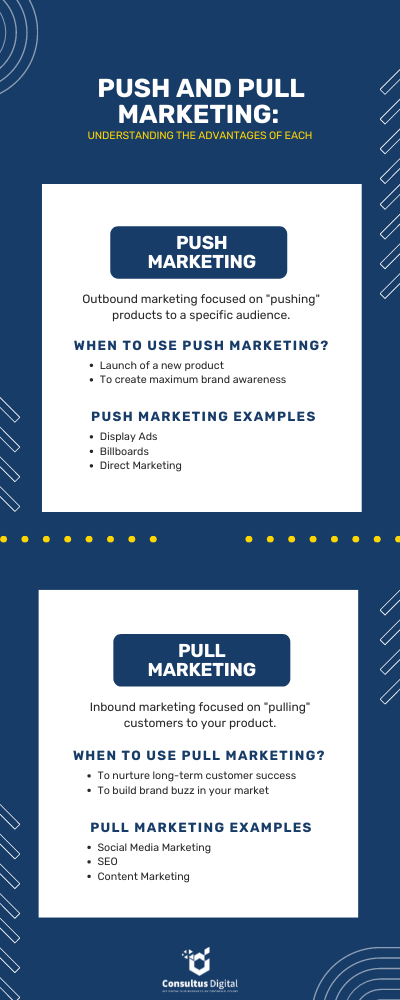
There are many components to a robust and cohesive digital marketing strategy, and you’ve likely heard them identified as “push” or “pull.” But what exactly are push and pull marketing strategies? Digital marketing can be broken down into these two types, indicating different ways of connecting with your target audience and driving conversions.
What are push and pull marketing strategies?
Essentially, push and pull marketing are two halves of a whole, and you need a combination of both. Combined, a push and pull marketing actic is a careful balance of promotions and creating demand to “push” customers towards a product and “pull” them in by building on initial interest, shopping preferences, and motivations.
Push marketing focuses on introducing your brand or items to your potential customers. When compared to other inbound marketing tactics, these types of marketing efforts are far more proactive and purposeful. Push marketing tactics are typically used by companies looking to take advantage of a brief window of time or produce short-term sales rapidly because it is a little more aggressive than the alternative.
Conversely, pull marketing focuses on traffic that comes in organically. The idea is to provide valuable content that appeals to your target audiences and then wait for them to approach you. Naturally, this does not imply inaction. Pull marketing is the practice of recognizing that existing customers are already actively looking for the goods, services, or information you provide and making it simpler for them to locate it and reach their destination.
So, how do you create this balance? In this blog, we’ll break down the key differences between push and pull marketing and show how they work together.
<pclass=”wp-block-image”>

What is push marketing?
In the simplest terms, a push marketing strategy is promotion-heavy. It’s focused on getting products directly in front of new customers, beginning with the manufacturing process and supply chain management.
Push marketing begins with “pushing” intermediaries like wholesalers and retailers to increase product inventories. With more products placed directly in front of customers, push marketing involves directly advertising features, benefits, and other unique selling propositions.
When to use push marketing? 3 Examples
Push marketing tactics are often used when you’re launching a new product. You’ll want to create maximum brand awareness and “push” the product toward as many customers as possible. The combination of a stellar product and highly targeted ads can generate sales faster, as customers become highly motivated to get their hands on the hottest and latest.
Keep in mind, though, that in addition to timing, push marketing relies heavily on outbound marketing and sales. This means, that for a push strategy to work, it needs to be backed by a strong sales team that is actively working to build customer relationships. This includes offering discounts and special promos — selling less than the cost of production and making up the difference through sales that exceed targets and forecasts.
Examples of Push Marketing Strategies
- Display Ads
Paid placements like banner ads and PPC campaigns on search and social media are some of the most effective display ads. These are highly targeted to your customer demographics — their location, age, gender, and shopping preferences, and centred on an offer, like a promo code or limited-time discount. A push strategy aims to drive customers to your website where they can complete the purchase after accessing an offer.
- Billboards
The offline, legacy counterpart of display ads and billboards are still effective in building brand awareness and advertising your latest product. Billboards are strategically placed in high-traffic areas to maximize reach and engagement. Now in the digital age, these offline, real-world placements can be combined with online components like a QR code that customers can scan to view an offer and make a purchase.
- Direct Marketing
As its name implies, direct marketing is built on engaging customers directly. This can happen in-store or at events like a trade show, pop-up, or conference. Direct marketing or advertising involves interacting with customers in real-time, such as offering samples or conducting product demos — essentially, creating a memorable product experience that allows you to connect with customers and sell to them instantly.
What is pull marketing?
Now, the polar opposite of a push, pull strategies creates demand for a product or service. It involves crafting effective messages that pique your target audience’s interest, drawing them in to fill out a contact form or ask about your latest offer.
Essentially, pull marketing tactics involve selling without the sales pitch — to be less overt and instead focus on your value proposition or what your brand (and only yours) can provide to customers. Many customers respond to pull marketing simply because they can grow annoyed by ads that are “too in their face.”
When to use pull marketing? 3 Examples
As the antidote to “pushy” ads, pull marketing works best because it’s ultimately dedicated to nurturing long-term customer success. This means engaging with customers across marketing channels, including your website and social media platforms, with value-added content that is personalized to their shopping journey.
A pull strategy builds on customers’ initial interest — like searching for a product or comparing competing offers — and crafts unique messages to engage customers and inspire loyalty. A pull strategy also allows you to customize the customer journey in order to build your sales funnel. Tailored content like emails, blogs, and guides demonstrate value to customers by providing relevant resources that gradually build brand loyalty and increase customer acquisitions.
Examples of Pull Marketing Strategies
- Social Media Marketing
Not to be confused with paid ads or PPC campaigns on social media, the organic side is full of possibilities for pull marketing. A “pull” social media marketing strategy leverages different content formats and platform features, from standard posts to Stories, Reels, videos, and more. Aside from brand content, you can partner with influencers to share unboxing videos, demos, and recommendations, host AMAs and takeovers, and use hashtag campaigns or any other temporary promotional campaigns to drive reach and engagement.
- SEO
Search Engine Optimization (SEO) is one of the classic examples of pull marketing strategies. It’s how you get your website visible and easily found by customers on the first page of search results in various search engines — the only place that matters. SEO is built on targeting relevant keywords and phrases that customers use to find products and brands like yours, allowing you to rank for these searches and connect with target audiences at the beginning of their shopping journey. Unlike PPC campaigns, SEO is all about organic rankings and reach, creating long-term opportunities for brand visibility and awareness.
- Content Marketing
Blogs, how-to guides, infographics, and email marketing are just some of the most common content marketing examples. Content marketing is another classic component of a pull strategy, aimed at creating the best value for your target audience. Rather than selling outright, content marketing strategies “pull” customers in by providing value-added information that makes an informed shopping decision. The more customers know about how your product (and your brand) can help them, the more you’re able to build customer trust and strengthen your sales funnel.
How to decide whether to use pull or push marketing?
When deciding whether to use push or pull marketing works, there are two broad categories to consider. The first factor is demand. Is there a high demand for your services or products already? Do you know where and how to find clients for this particular product at the point of sale, whether online or in person? Push marketing is the right approach for you if you can confidently respond to those queries.
The second factor is the unrealized needs of the customer. On the contrary, does your promotional strategy heavily rely on word-of-mouth marketing? Do you know whether your product meets a need that your clients are unaware they have? Or else whether they are yet to be made aware that your solution is the best one available for their requirement? If so, your best option is pull marketing.
Let’s Talk Push and Pull Marketing
There are distinct elements to push and pull marketing, but they work best together. A push and pull marketing strategy allows most marketers to create a balanced customer experience — just enough “push” to promote your newest product and latest offer and “pull” to create lasting customer relationships.
Simply, a combined push and pull marketing strategy creates demand in the market and closes the sale. To do this, you need both ads that highlight your unique offers, and a long-term marketing strategy that keeps customers engaged.
At Consultus Digital, we’re advocates of an integrated, well-timed, and relevant push and pull marketing strategy. We know you need both and how exactly to craft a unified approach across your marketing and sales channels to ensure long-term business growth. Our digital marketing agency in Toronto runs both types of campaigns, always with the goal of crafting a cohesive brand that “pulls” and “pushes” at the right time to enable sales.
Let’s talk about your push and pull marketing strategy. Contact Consultus Digital, Toronto’s leading agency for cohesive, custom-crafted, fully integrated push and pull marketing campaigns.
Recommended Articles
This Month's Strategy Can Define Your Year - Don't Miss Out!

4.9 stars from 43 entrepreneurs







 416-460-1810
416-460-1810
